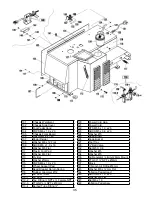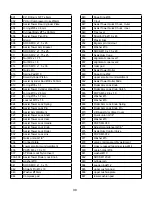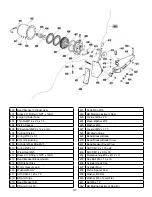
27
4. Depress inflation pedal and open the Turbo-Blast Valve
The blast of air from the Turbo Blast Nozzle will expand tire
and seal the beads.
5. Release the inflation pedal. Verify that both beads are
completely sealed to the wheel. Repeat these steps if beads
have not sealed. It may be necessary to wait a few seconds
for the air storage tank to recover before attempting again.
If tire and wheel are properly lubricated and operator cannot
achieve bead seal after a few attempts, the valve core should
be removed from the valve stem to allow more air flow into
the tire to assist with bead seal. After bead seal is achieved,
remove the chuck and reinstall the valve core.
STAgE THREE / BEAD SEATINg
Bead seating usually occurs on the long tapered side of the
wheel first and the shorter side last. Bead seating will usu-
ally require at least 7 PSI in the tire. 40 PSI is the maximum
safe pressure at this stage regardless of tire operating pres-
sure. Most European import cars and many aftermarket
alloy wheels are very tight and can be difficult to bead seat.
Also note that asymmetrical hump and run-flat tires are
extremely difficult to bead seat. Follow tire manufacturer’s
recommended procedure for bead seating.
1. Once tire pressure is indicated on the pressure gauge
continue to inject air into the tire in short intervals. Check
the pressure frequently. Stand back during bead seat. Keep
hands, arms, and entire body away from tire during this
procedure. Tire beads should move outward and “pop” into
their bead seat position as pressure inside the tire increas-
es. If this does not happen, a problem exists. Investigate
carefully. (See Fig 14.12)
2. Release air pressure from the tire by pressing the manual
Pressure Relief Valve. (See Fig 14.13)
wARNINg!
OPERATOR SHOULD KEEP HANDS, ARMS, AND ENTIRE
BODY AWAY FROM THE TIRE DURING THE FOLLOW-
ING BEAD SEAT AND INFLATION PROCEDURES. DO
NOT STAND OVER TIRE, AS PERSONAL INjURY COULD
RESULT FROM INFLATING TIRE. AVOID DISTRACTION
DURING INFLATION. CHECK TIRE PRESSURE FREqUENT-
LY TO AVOID OVER INFLATION. EXCESSIVE PRESSURE
CAN CAUSE TIRES TO EXPLODE, CAUSING SERIOUS
INjURY OR DEATH TO OPERATOR OR BYSTANDER.
Fig 14.12
Fig 14.13
Pressure
Gauge
Pressure
Relief
Valve
NOTE:
THE INFLATION HOSE MUST BE ATTACHED TO THE
VALVE STEM DURING THIS PROCEDURE.
Содержание R30XLT
Страница 34: ...34 ...
Страница 38: ...38 ...
Страница 43: ...43 ...
Страница 45: ...45 ...
Страница 46: ...46 RECORD ALL MAINTENANCE NOTES AND SERVICE HISTORY HERE ...
Страница 47: ...47 TIRE AND WHEEL DATA ...

































